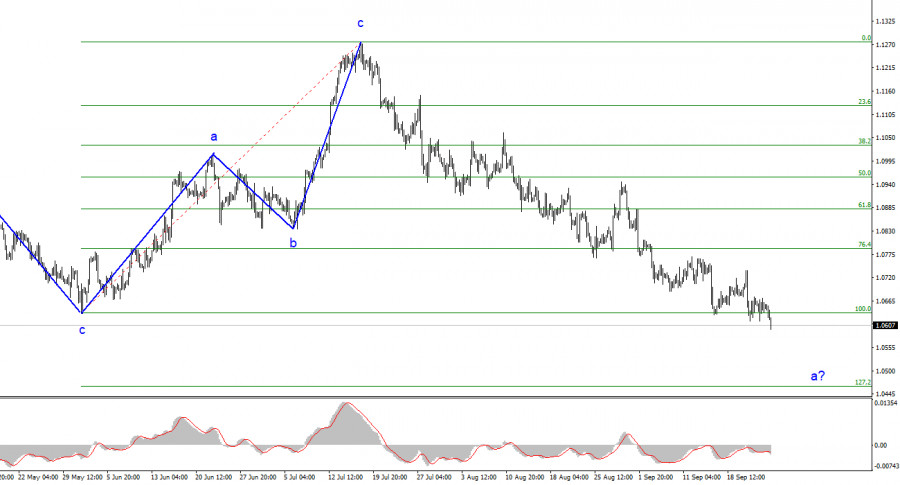

The wave analysis of the 4-hour chart for the euro/dollar pair remains quite clear. Over the past year, we have seen only three wave structures that constantly alternate with each other. For the past few months, I have regularly mentioned that I expect the pair to be around the 5th figure, from where the construction of the last upward three-wave movement began. The pair has yet to reach the 5th figure, but it has already overcome the 6th figure. And yet, even the first wave of the new downward trend has not been completed. Can you imagine the levels to which the euro may fall in a few months?
None of the recent price increases resembled a full-fledged wave 2 or b. Therefore, all of them were internal corrective waves in 1 or a. If this is true, the price decline may continue within this wave. And this will not mark the end of the overall decline of the European currency, as the construction of the third wave is still required. Five internal waves are already visible within the first wave, so its completion is approaching. But still, a successful attempt to break the level of 1.0637, which is equivalent to 100.0% according to Fibonacci, indicates the market's readiness for additional pair sales.
The euro would like to rise, but there is no reason to do so.
On Monday, the euro/dollar pair rate dropped by another 60 basis points. This decline seems surprising since today's news background was relatively weak. There were no important reports, and we have already heard much from ECB members over the past few weeks. However, if you look at the situation with the euro from the outside, its decline seems entirely justified. On Friday, business activity indices in the European Union and Germany were again weak. The euro may have been preparing for growth, but the news disappointed it again. Today, Pablo Hernandez de Cos and Francois de Gallo stated that new interest rate hikes are unlikely to be seen by the markets. They believe the current rate level will be sufficient to bring inflation back to 2% over time. We didn't hear anything new (similar statements were made by other members of the Governing Council last week). Still, these were additional nails in the coffin of the European currency, a few more reasons to sell rather than buy.
I have previously noted that the euro will fall more actively when the ECB pauses or stops tightening monetary policy. A few months ago, the market did not fully understand what level to expect for the rate increase, but now it is well understood. And this level is incomparable with the Federal Reserve rate.

Based on the analysis, the construction of a downward set of waves continues. The targets for the downward trend in the range of 1.0500-1.0600 are realistic. Therefore, I continue to recommend selling the pair. Since the downward wave has not been completed near the 1.0637 level, we can now expect a decline to the 5th figure and slightly lower. However, the second corrective wave will start sooner or later.
On the larger wave scale, the wave marking of the upward trend has taken on an extended form but is likely completed. We have seen five upward waves, most likely the structure of a-b-c-d-e. The pair then formed four three-wave movements: two down and two up. It has moved on to the stage of building another descending three-wave structure.